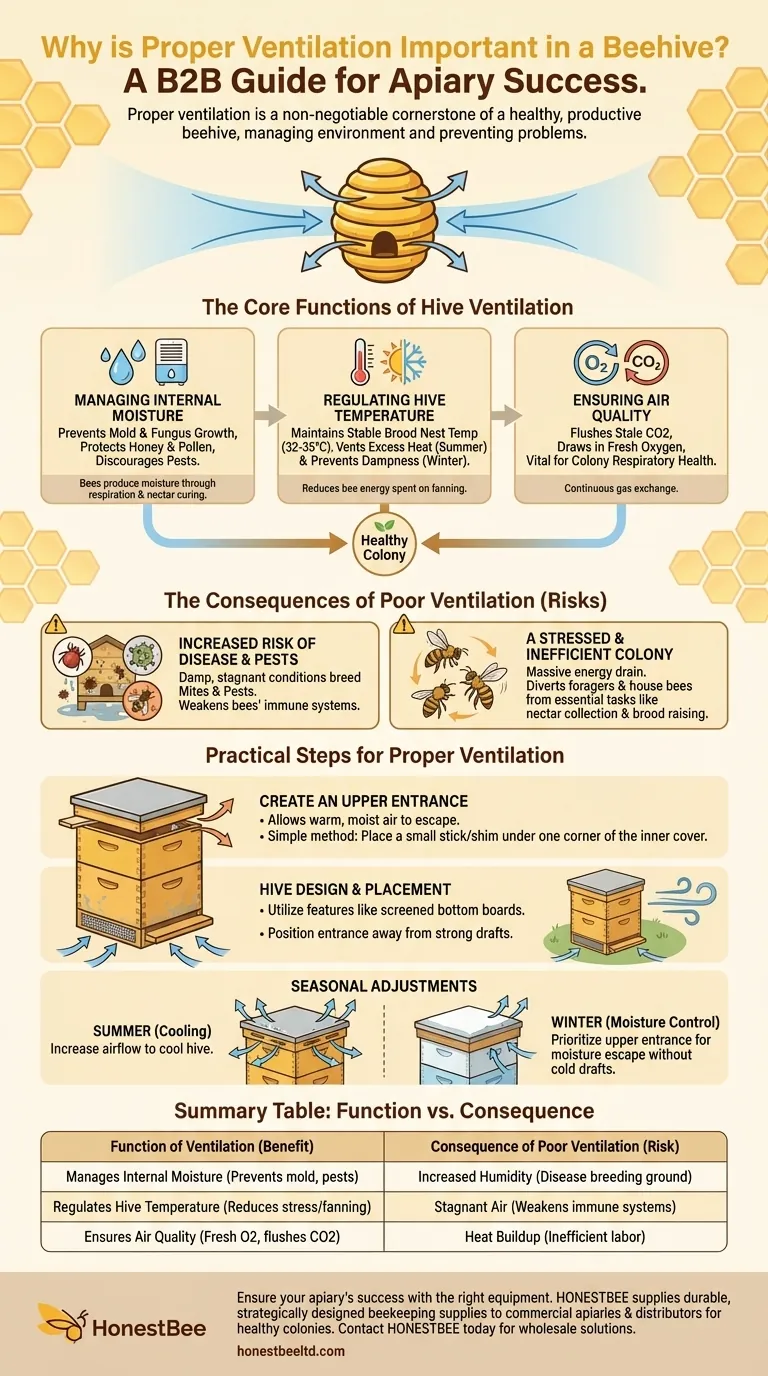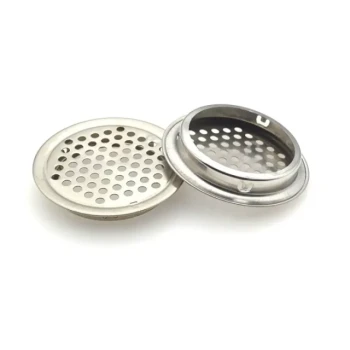Proper ventilation is a non-negotiable cornerstone of a healthy beehive. It is the primary mechanism for regulating the hive's internal environment by managing moisture, controlling temperature, and ensuring proper air quality. A well-ventilated hive allows the colony to thrive by preventing the growth of mold and fungus, reducing stress on the bees, and minimizing the risk of pest infestations.
The beekeeper's goal isn't to create a draft but to facilitate the bees' own remarkable ability to control their environment. Proper ventilation empowers the colony to efficiently manage heat and moisture, preventing a cascade of problems that undermine their health and productivity.

The Core Functions of Hive Ventilation
A beehive is a living, breathing superorganism that generates significant amounts of heat, moisture, and carbon dioxide. Ventilation is critical for managing these byproducts.
Managing Internal Moisture
Bees produce moisture through two main activities: respiration and curing nectar into honey. Without an escape route, this warm, moist air condenses on cooler inner surfaces, creating a damp environment.
This excess moisture is dangerous because it encourages the growth of mold and fungus, which can spoil honey and pollen stores. It also creates ideal conditions for pests and pathogens to flourish.
Regulating Hive Temperature
Bees work tirelessly to maintain a stable temperature, especially in the brood nest where larvae develop (typically 32-35°C or 90-95°F).
In hot weather, proper airflow allows excess heat to escape, reducing the energy the bees must expend fanning their wings to cool the hive. In winter, ventilation prevents the buildup of damp air, which can chill and kill the colony far more quickly than cold, dry air.
Ensuring Air Quality
Like any living organism, a bee colony consumes oxygen and releases carbon dioxide (CO2).
Adequate ventilation ensures a continuous exchange of gases, flushing out stale, CO2-heavy air and drawing in fresh oxygen. This is vital for the colony's overall health and respiratory function.
The Consequences of Poor Ventilation
Failing to ensure proper airflow can lead to a host of preventable problems that can weaken or destroy a colony.
Increased Risk of Disease and Pests
A damp, stagnant hive is a breeding ground for trouble. Mites and other pests thrive in humid conditions.
Furthermore, the stress caused by poor environmental control can weaken the bees' immune systems, making them more susceptible to diseases.
A Stressed and Inefficient Colony
When bees are forced to compensate for poor ventilation, they must divert significant energy and labor toward fanning.
This is a massive drain on the colony's resources. It takes foragers away from collecting nectar and pollen, and it diverts house bees from tasks like raising brood and building comb.
Practical Steps for Proper Ventilation
Achieving good ventilation is about creating a path for air to move through the hive, typically from a bottom entrance to an upper exit.
The Importance of an Upper Entrance
Warm, moist air naturally rises. Providing a small opening at the top of the hive allows this air to escape before it condenses.
A simple and effective method is to place a small stick or shim under one corner of the inner cover, creating a small gap for air to exit.
Hive Design and Placement
Many modern hives, such as the Flow Hive, have built-in ventilation features like screened bottom boards or ventilation holes in the roof. It is critical to ensure these remain unblocked.
The hive's location also matters. Position the entrance away from prevailing winds to prevent strong drafts, especially during colder months.
Seasonal Adjustments
Ventilation needs change with the seasons. In hot summers, you may need to increase airflow to help the bees cool the hive.
In winter, the goal shifts to moisture control without creating a cold draft. A small upper entrance becomes especially critical to vent the moisture produced by the overwintering cluster.
Making the Right Choice for Your Colony
Ultimately, ventilation strategy is about balancing the needs of the bees with the challenges of your local climate.
- If your primary focus is hot summer management: Ensure there are both lower and upper openings to create a natural convection current that vents excess heat.
- If your primary focus is cold winter survival: Prioritize a small, unobstructed upper entrance to allow moist air to escape, keeping the bees' living space dry.
Providing proper ventilation is one of the most effective ways you can support your colony's natural behaviors and ensure its long-term health.
Summary Table:
| Function of Ventilation | Benefit to the Colony |
|---|---|
| Manages Internal Moisture | Prevents mold, fungus, and pest infestations |
| Regulates Hive Temperature | Reduces bee stress and energy spent on fanning |
| Ensures Air Quality | Flushes out CO2 and provides fresh oxygen |
| Consequence of Poor Ventilation | Risk to the Colony |
| Increased Humidity | Creates a breeding ground for disease |
| Stagnant Air | Weakens bees' immune systems |
| Heat Buildup | Forces bees into inefficient labor |
Ensure your apiary's success with the right equipment. Proper ventilation starts with a well-designed hive. HONESTBEE supplies durable, strategically designed beekeeping supplies and equipment to commercial apiaries and distributors. Our wholesale-focused operations ensure you get the reliable gear you need to support healthy, productive colonies.
Contact HONESTBEE today to discuss your equipment needs and secure your hive's future.
Visual Guide

Related Products
- Stainless Steel Round Beehive Air Vents for Ventilation
- Telescopic Beehive Outer Cover Lid Roof with Galvanised Sheeting for Langstroth Hive and Beehive Outer Cover
- Inner Beehive Cover for Beekeeping Bee Hive Inner Cover
- Professional Insulated Winter Hive Wrap for Beekeeping
- Long Langstroth Style Horizontal Top Bar Hive for Wholesale
People Also Ask
- What is the recommended orientation for the rim of an inner cover? Master Hive Ventilation and Insulation
- What happens if there is no ventilation at the top of a hive in winter? Prevent Deadly Condensation and Colony Loss
- How is the inner cover used to promote ventilation? Master Hive Climate Control for Healthy Bees
- How can a beekeeper create a notch in an inner cover? Improve Ventilation and Hive Management
- What is the key to thriving in beekeeping during challenging winters? Master the Heat-Moisture Balance



















